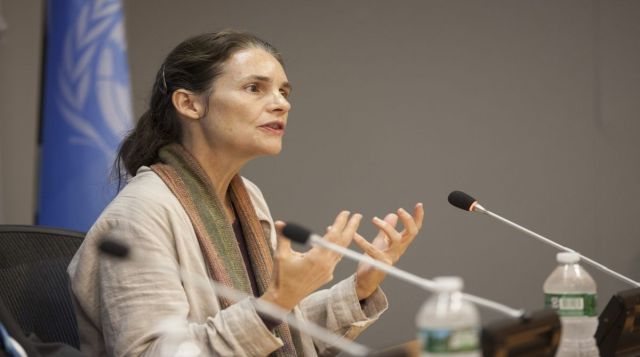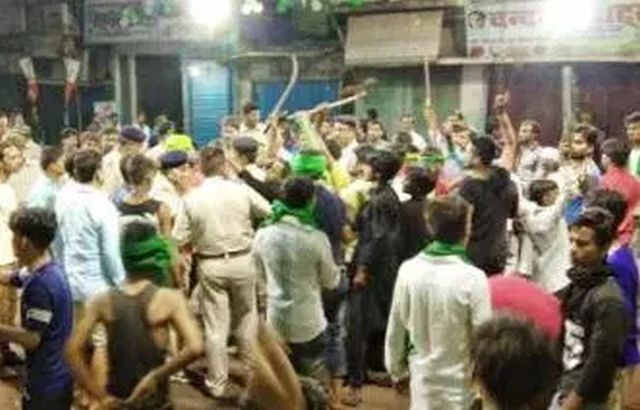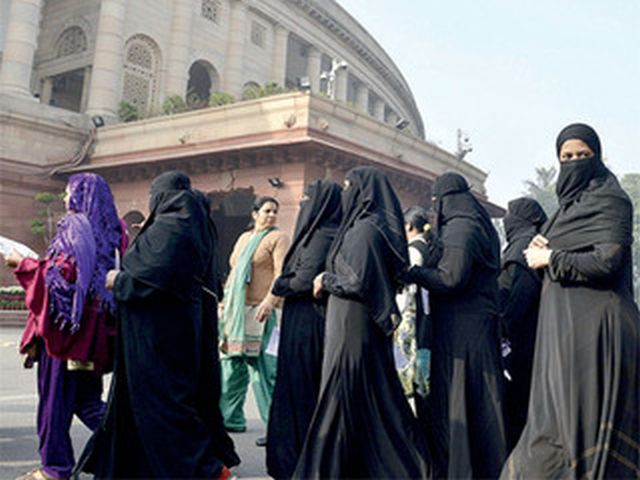
by admin | May 25, 2021 | News
 Mumbai : Actor John Abraham on Friday unveiled the first look of his film “Batla House”, and announced that it will hit the screens on August 15, 2019, clashing with “Brahmastra” and “Made In China”.
Mumbai : Actor John Abraham on Friday unveiled the first look of his film “Batla House”, and announced that it will hit the screens on August 15, 2019, clashing with “Brahmastra” and “Made In China”.
The “Batla House” makers is based on a real-life incident about the Delhi spot where a shootout took place in 2008.
John posted the film’s poster on Twitter and wrote: “Every story has two points of view. One wrong. The other right. But what if the lines are blurred? Very very blurred!”
Known for doing patriotic movies like “Madras Cafe” and “Parmanu – The Story Of Pokhran” and his latest release “Satyameva Jayate”, John will once again be seen donning the patriotism on his sleeve in “Batla House” by essaying police officer Sanjay Kumar Yadav who led the Batla House encounter.
In the poster, John can be seen in a policeman’s avatar and he is surrounded with several news headlines of the encounter.
Helmed by director Nikkhil Advani, the film is written by Ritesh Shah.
While announcing the release date, Advani tweeted: “Have waited for a long time for this story to be told. Unveiling an explosive account of one of the most controversial events to have rocked modern India.”
—IANS

by admin | May 25, 2021 | News, Politics

Sabina Alkire, Director of Oxford Poverty & Human Development Initiative
By Arul Louis,
United Nations : While India has taken tremendous strides in combating poverty in the past decade, Muslims, members of the Scheduled Tribes (ST) and Dalits saw the most progress in in reducing the impact of poverty, according to data compiled in a UN project.
The “very positive trend” during the decade between 2005-06 and 2015-16 in India is that “the poorest are catching up”, Sabina Alkire, Director of the Oxford Poverty and Human Development Initiative (OPHDI), said on Thursday at the presentation of the 2018 Multidimensional Poverty Index (MPI) here.
The MPI prepared by the UN Development Programme (UNDP) and the OPHDI, takes into account various indicators of development rather than just income and aligns them to the UN Sustainable Development Goals, while serving as a measure of the intensity of poverty felt by different groups.
While ST members were still the poorest group, they have seen the fastest reduction in MPI, as have the Dalits, Alkire said.
Explaining it, Diego Zavaleta Reyles from OPHDI told IANS that the average number of deprivations or “the intensity of their poverty” measured by the MPI fell for these groups even though the proportion of poor people in these categories was relatively the same or unchanged.
Between 2006 and 2016, the MPI of the STs came down from 0.447 to 0.229 even though the percentage had fallen only from 79.8 to 50 during the decade, according to OPHDI data.
During the same period, the MPI of Dalits fell from 0.338 to 0.145 while the percentage of poor came down from 65 to 32.9.
“If we look at the religious groups, the Muslims are the poorest and they again had the fastest reduction in MPI,” Alkire said.
While MPI for Muslims was 0.331 in 2006, it fell to 0.144 in 2016, and the percentage of the poor in the community came down from 60.3 per cent to 31.1 per cent.
Nationally, 54.7 per cent of the people in all groups taken together were poor in 2006, but only 27.5 per cent in 2016, and the MPI came down from 0.279 to 0.121, the data show.
In terms of numbers, 271 million people had moved out of poverty during the decade, with the number of poor people coming down 635 million in 2005-06 to 364 million according to the MPI standards.
But “we are seeing a shift of global proportions occurring in India over a ten-year period and that is really encouraging”, Alkire said.
India is the only country for which changes of this magnitude are taking place at this time, she added.
Bihar remains the poorest state, but along with other high-poverty states – Jharkhand, Madhya Pradesh, Uttar Pradesh and Chhatisgarh – had the fastest reduction in multi-dimensional poverty, she said.
In spite of the progress, these states still remain the poorest.
Among age groups, children, who are still the poorest, saw the fastest reduction in MPI, she said.
Such reduction in poverty among these groups or states did had not happened in India in the earlier periods according to a previous study for the period 1998-1999 to 2005-06, she said.
UNDP Administrator Adam Steiner said that when governments start looking carefully at who the poor are and where they are, the analysis leads to programmes that help the poorest of the poor, whether by ethnicity, religion or geography, and results like those in India can be achieved.
Traditional poverty measures – often calculated by numbers of people who earn less than $1.90 a day – shed light on how little people earn but not on whether or how they experience poverty in their day-to-day lives, according to UNDP.
On the other hand, MPI takes into account health, education and living standards in areas like access to clean water, sanitation, nutrition and primary education, with those lacking in at least a third of these defined as multi-dimensionally poor.
According to the income-based measurement, only 270 million Indians are considered poor but according to the MPI standards a far larger number – 364 million — were categorised as multi-dimensionally poor in 2016.
(Arul Louis can be reached at arul.l@ians.in and followed on Twitter at @arulouis)
—IANS

by admin | May 25, 2021 | News, Politics
 Patna : A youth was killed and another injured in Bihar’s Hajipur on Friday morning by unidentified assailants ahead of the Tazia procession to mark Muharram, police said.
Patna : A youth was killed and another injured in Bihar’s Hajipur on Friday morning by unidentified assailants ahead of the Tazia procession to mark Muharram, police said.
Police Station Officer Incharge Om Prakash said a youth was shot dead near Masjid Chowk and another sustained serious bullet injuries.
Angry over the incident, residents blocked roads, shouted slogans against the state government and staged protests for hours.
The district administration has imposed Section 144 of the Code of Criminal Procedure (CrPC) in Masjid Chowk area, 30km from here. Heavy security forces have been deployed to maintain law and order.
—IANS

by admin | May 25, 2021 | News, Politics
 New Delhi : A number of Muslim organisations on Thursday slammed the triple talaq ordinance, calling it politically motivated and “unacceptable”.
New Delhi : A number of Muslim organisations on Thursday slammed the triple talaq ordinance, calling it politically motivated and “unacceptable”.
Jamat-e-Islami Hind President Maulana Syed Jalaluddin Umari in a statement said that if the government is sincere about the welfare of Muslim women, it should hold discussion with ‘ulema’ (Islamic scholars) and experts of Islamic jurisprudence over the entire talaq-e-biddat (triple talaq) issue.
The Union Cabinet cleared the ordinance on Wednesday, and it was promulgated by the President. The ordinance prescribes up to three years jail and/or fine for the man who divorces his wife through triple talaq or instant divorce.
“The ordinance is against the Constitution of India that gives every citizen liberty to practise one’s religion and personal laws. The ordinance contravenes the Shariah laws,” said Maulana Umari.
Jamiat Ulema-e-Hind General Secretary Maulana Mahmood Madani said the ordinance was not going to favour the divorced women in any way and would instead harm their cause for justice.
Law Minister Ravi Shankar Prasad on Wednesday called the promulgation of Ordinance as “constitutional urgency.” Madani responded by saying that 201 incidents of talaq in two years or 100 cases per annum in 16-crore Muslim community “does not warrant such a hasty ordinance”.
“It is a clear instance of dictatorship. The government did not even feel the need to consult the community,” he said.
All India Muslim Majlis-e-Mushawarat (AIMMM) President Navaid Hamid said the move was nothing but a “diversionary tactic” by the Modi government to deflect attention from its own failures and burning issues such as rising fuel prices and corruption.
“We should not even react to such provocations. I reckon the Modi government’s sole aim with this ordinance is to incite Muslims so that BJP can give it a communal colour and deflect attention from real issues,” Hamid told IANS.
“If the government is so sincere about the welfare of Muslim women, it should tell us what it is doing for the Muslim widows whose husbands have been killed in lynching cases over the last four years,” he added.
—IANS

by admin | May 25, 2021 | Opinions
 By Ashok Easwaran,
By Ashok Easwaran,
At its best, speeches at the recently concluded World Hindu Congress echoed the soaring spiritual ideals evoked by Swami Vivekananda in Chicago 125 years ago.
Even Mohan Bhagwat, Sarsangchanalak of the Rashtriya Swayamsevak Sangh (RSS), focused essentially on the need for unity and patience among Hindus while fighting obstacles, of which, he said, there would be many. The burden of excavating implied accusations in Bhagwat’s speech fell to his critics.
At the plenary session, the moderator requested speakers to address issues of conflict without naming the speakers or their organisations in the interest of harmony. Other speakers sought to unite the followers of all the great religions that took birth in India — Hinduism, Sikhism, Buddhism and Jainism.
Some of the speakers from Bhagwat to Swami Swaroopananda of the Chinmaya Mission, framed the issues before Hinduism in a moral paradigm. Ashwin Adhin, the Vice President of the Republic of Suriname, began his speech in chaste Hindi, later quoting cognitive scientist George Lakoff: “Facts matter immensely. But to be meaningful they have to be framed in terms of their moral importance.”
The dissonances, between the spiritual and the mundane, were to emerge later on the fringes of the seminars which were part of the Congress. Many of the delegates appropriated to themselves the mantle of a culture besieged by proselytising faiths. There were speakers who urged Hindus to have more children to combat their ‘dwindling population’. Posters warned Hindus of the dangers from ‘love jihad’ (Muslim men ‘enticing’ Hindu women).
In one of the sessions on the media, filmmaker Amit Khanna noted that religion had always played a prominent part in Indian cinema, starting with the earliest mythologicals. “Raja Harishchandra”, the first silent film, he said, was made by Dadasaheb Phalke in 1913. He sought to reassure the audience on the future of Hinduism. “Over 80 percent of Indians are Hindus,” he said adding: “Hinduism has survived many upheavals for thousands of years. Hinduism has never been endangered.”
Other speakers, lacking spiritual and academic pedigrees, drew on an arsenal of simulated anguish and simmering indignation.
The nuances of history pass lightly over the ferociously devout and it took little effort to pander to an aggravated sense of historical aggrievement.
At one of the debates, the mere mention of Jawaharlal Nehru, India’s first Prime Minister, elicited sniggers and boos. The speaker hinted at ‘Nehruvian socialism’ which had made the Indian economy a non-starter. He concluded with a coup de grace, to a standing ovation: “Nehru did not like anything Indian.”
The poet Rabindranath Tagore, who composed the Indian national anthem, had spoken of his vision of a country where the “clear stream of reason had not lost its way”. At some of the discussions, even the most indulgent observer would have been hard put to discern the stream of reason.
The image of a once great civilisation suppressed by a century of British rule and repeated plunder by invaders captured the imagination of many in the audience. Hanging above it all, like a disembodied spirit, was the so-called malfeasance of Nehru, the leader who had won the trust of Hindus only to betray them in the vilest manner.
These tortured souls would have been well advised to adopt a more holistic approach to Hinduism, and history, looking no further than Swami Vivekananda, who once said: “The singleness of attachment (Nishtha) to a loved object, without which no genuine love can grow, is very often also the cause of denunciation of everything else.”
Historians have informed us that Nehru preferred his father’s intellect over his mother’s tradition but he was never contemptuous of religion. While he undoubtedly felt that organised religion had its flaws, he opined that it supplied a deeply felt inner need of human nature while also giving a set of values to human life.
In private conversations some delegates spoke of how their America-born children had helped persuade them to drop their pathological aversion to gays and lesbians. Despite their acute wariness of perceived cultural subjugation, the irony was obviously lost on them that Article 377 of the Indian Penal Code,(which criminalises gay sex) recently overturned by the Indian Supreme Court, is a hangover from the Victorian British era-embodied in the Buggery Act of 1533.
In the face of the upcoming elections in the US, Congressman Raja Krishnamoorthi’s decision to speak at the conference was a political risk. With a newly energised political Left, even the perception of being linked with “fascist” or sectarian forces could be political suicide in the critical November elections. Despite vociferous appeals to disassociate himself from the Congress, Krishnamoorthi chose to attend.
“I decided I had to be here because I wanted to reaffirm the highest and only form of Hinduism that I have ever known and been taught — namely one that welcomes all people, embraces all people, and accepts all people, regardless of their faith. I reject all other forms. In short, I reaffirm the teaching of Swami Vivekananda,” Krishnamoorthi said.
Given the almost pervasive abhorrence of anything remotely Nehruvian among a section of the delegates, it was a revelation to hear the opinion of Dattatrey Hosable, the joint general secretary and second-in-command in the RSS hierarchy. Speaking on the promise of a newly-resurgent India, Hosable said in an interview to Mayank Chhaya, a local journalist-author-filmmaker: “A moment comes, which comes but rarely in history, when we step out from the old to the new — when an age ends, and when the soul of a nation, long suppressed, finds utterance.”
The quote is from Nehru’s famous Tryst with Destiny speech delivered to the Indian Constituent Assembly on the midnight of August 14, 1947 — proof, if any is needed, that the force of Nehru’s ideas can transcend one’s disdain of him.
(Ashok Easwaran is an American journalist of Indian origin. The views expressed are personal. He can be contacted at ashok3185@yahoo.com)
—IANS

 Mumbai : Actor John Abraham on Friday unveiled the first look of his film “Batla House”, and announced that it will hit the screens on August 15, 2019, clashing with “Brahmastra” and “Made In China”.
Mumbai : Actor John Abraham on Friday unveiled the first look of his film “Batla House”, and announced that it will hit the screens on August 15, 2019, clashing with “Brahmastra” and “Made In China”.



